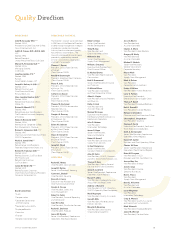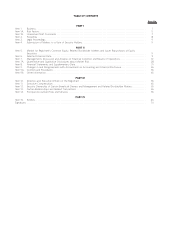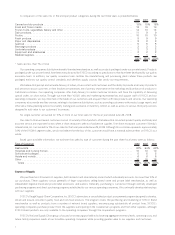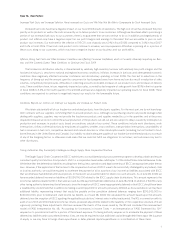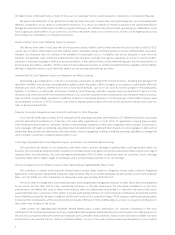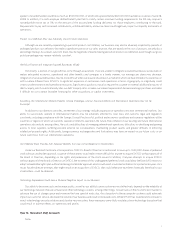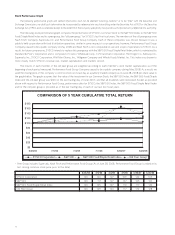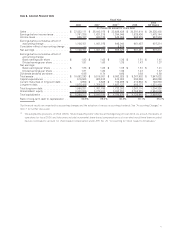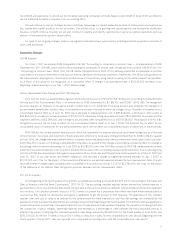Sysco 2008 Annual Report Download - page 27
Download and view the complete annual report
Please find page 27 of the 2008 Sysco annual report below. You can navigate through the pages in the report by either clicking on the pages listed below, or by using the keyword search tool below to find specific information within the annual report.The National Supply Chain group has three major supply chain initiatives. The first initiative involves the construction and operation of
regional distribution centers which aggregate inventory demand to optimize the supply chain activities for certain products for all SYSCO
broadline operating companies in the region. We currently expect to build five to seven redistribution centers (RDCs). The first of these
centers, the Northeast RDC located in Front Royal, Virginia, has been operational since the third quarter of fiscal 2005. A second RDC
located in Alachua, Florida became operational in the fourth quarter of fiscal 2008. In fiscal 2009, we intend to service additional broadline
companies from our existing RDCs. The second initiative is the national transportation management initiative, which provides the capability
to view and manage all of SYSCO’s inbound freight, both to RDCs and the operating companies, as a network and not as individual locations.
This allows us to better consolidate inbound freight. Fiscal 2008 was the first full year we operated under this initiative, and we will continue
to refine our execution in the future. The third initiative is the national implementation of demand planning and inventory management
software. This initiative is strategically important in that it creates the foundation to effectively execute new supply chain processes,
including redistribution, as well as efficiently manage our inventory assets. In fiscal 2008, we continued to improve this software and
implemented it at additional broadline companies.
Working Capital Practices
Our growth is funded through a combination of cash flow from operations, commercial paper issuances and long-term borrowings. See
the discussion in Liquidity and Capital Resources under Management’s Discussion and Analysis of Financial Condition and Results of
Operations at Item 7 regarding our liquidity, financial position and sources and uses of funds.
Credit terms we extend to our customers can vary from cash on delivery to 30 days or more based on our assessment of the customers’
credit risk. We monitor the customers’ accounts and will suspend shipments to customers if necessary.
A majority of our sales orders are filled within 24 hours of when the customers’ orders are placed.We generally maintain inventory on hand to
be able to meet customer demand.The level of inventory on hand will vary by product depending on shelf-life, supplier order fulfillment lead times
and customer demand. We also make purchases of additional volumes of certain products based on supply or pricing opportunities.
We take advantage of suppliers’ cash discounts where appropriate and otherwise generally receive payment terms from our suppliers
ranging from weekly to 30 days or more.
Corporate Headquarters’ Services
Our corporate staff makes available a number of services to our operating companies. Members of the corporate staff possess
experience and expertise in, among other areas, accounting and finance, treasury, cash management, information technology, employee
benefits, engineering, risk management and insurance, sales and marketing, payroll, human resources, training and development, infor-
mation technology and tax compliance services. The corporate office also makes available warehousing and distribution services, which
provide assistance in operational best practices including space utilization, energy conservation, fleet management and work flow.
Capital Improvements
To maximize productivity and customer service, we continue to construct and modernize our distribution facilities. During fiscal 2008, 2007
and 2006, approximately $515,963,000, $603,242,000 and $513,934,000 respectively, were invested in facility expansions, fleet additions and
other capital asset enhancements. The lower amount spent in fiscal 2008 was primarily due to delays on certain projects that will shift significant
expenditures to fiscal 2009. As a result, we estimate our capital expenditures in fiscal 2009 should be in the range of $675,000,000 to
$725,000,000. During the three years ended June 28, 2008, capital expenditures were financed primarily by internally generated funds, our
commercial paper program and bank and other borrowings. We expect to finance our fiscal 2009 capital expenditures from the same sources.
Employees
As of June 28, 2008, we had approximately 50,000 full-time employees, approximately 17% of whom were represented by unions,
primarily the International Brotherhood of Teamsters. Contract negotiations are handled by each individual operating company. Approx-
imately 21% of our union employees are covered by collective bargaining agreements which have expired or will expire during fiscal 2009.
We consider our labor relations to be satisfactory.
Competition
SYSCO’s business environment is competitive with numerous companies engaged in foodservice distribution. Our customers may also
choose to purchase products directly from retail outlets. While competition is encountered primarily from local and regional distributors, a few
companies compete with us on a national basis.We believe that the principal competitive factors in the foodservice industry are effective customer
contacts, the ability to deliver a wide range of quality products and related services on a timely and dependable basis and competitive prices. We
estimate that we serve about 16% of an approximately $231 billion annual market that includes the foodservice market in the United States and
Canada and the hotel amenity, furniture and textile markets in the United States, Canada, Europe and Asia. We believe, based upon industry trade
data, that our sales to the United States and Canada “food-prepared-away-from-home” industry were the highest of any foodservice distributor
during fiscal 2008. While adequate industry statistics are not available, we believe that in most instances our local operations are among the
leading distributors of food and related non-food products to foodservice customers in their respective trading areas. We believe our competitive
3



